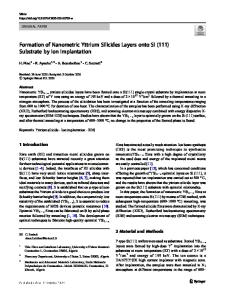Synthesis of Continuous SmSi 2 Layers on Si by Samarium Ion Implantation Using A Metal Vapor Vacuum Arc Ion Source
- PDF / 1,501,749 Bytes
- 6 Pages / 612 x 792 pts (letter) Page_size
- 65 Downloads / 391 Views
Synthesis of Continuous SmSi2 Layers on Si by Samarium Ion Implantation Using A Metal Vapor Vacuum Arc Ion Source
X.Q.Cheng, H.N.Zhu and B.X.Liu Department of Materials Science and Engineering Tsinghua University, Beijing 100084, CHINA
ABSTRACT Samarium ion implantation was conducted to synthesize Sm-disilicide films on silicon wafers, using a metal vapor vacuum arc ion source and the continuous SmSi2 films were directly obtained with neither external heating during implantation nor post-annealing. Diffraction and surface morphology analysis confirmed the formed Sm-disilicilde films were of a fine crystalline structure under appropriate experimental conditions. Besides, the formation mechanism of the SmSi2 phase is also discussed in terms of the temperature rise caused by ion beam heating and the effect of ion dose on the properties of the SmSi2 films.
INTRODUCTION Rare-earth (RE) metal silicides have attracted considerable attention because of their lowest Schottky barrier height (0.3~0.4eV) compared with other silicides on an n-type silicon surface [1-3], and because of their potential applications in the fabrication of infrared detectors. Accordingly, various techniques have been developed to synthesize RE metal silicides, such as solid state reaction (SSR) and ion beam synthesis (IBS). It was reported that in SSR, the interaction between the RE metals and single crystalline silicon behaved a “critical temperature” phenomenon, i.e. below the critical temperature (300-350°C), the interaction was very sluggish, whereas the interaction was explosive and out of control if the reaction was beyond the critical temperature [4-6]. Furthermore, the RE metal silicide layers formed by SSR were typically dominated with some heavy pits [7], which have a detrimental effect on their electronic performance. In the conventional IBS technique, it generally consists of two steps. Firstly, the high dose metal ions were implanted into Si wafers, which were simultaneously heated by some external means to a temperature of 400±50°C. Secondly, a post-annealing was conducted after implantation to form the RE metal silicide layers, which were frequently discontinuous [8]. In 1995, continuous buried RE metal silicide layers with good crystallinity were obtained by channeling-IBS technique [9], in which a high temperature post-annealing was also necessary and it would affect the properties of the integrated circuits. In the mid-1980s, a new ion source was invented, namely the metal vapor vacuum arc (MEVVA) ion source [10] and in the early 90s it was employed by the authors’ group to successfully synthesize some important metal silicides on Si wafers, such as C54-TiSi2, β-FeSi2, CoSi2, NiSi2 and ZrSi2, etc [11-15]. As a continuation, we investigate, in the present study, the O5.29.1
possibility of directly synthesizing the Sm-disilicide layers on silicon wafers by high current Sm ion implantation using MEVVA ion source.
EXPERIMENTAL DETAILS The silicon wafers used in this study were n-type Si (100) with resistivity of 30 to 50 Ωcm. The
Data Loading...










